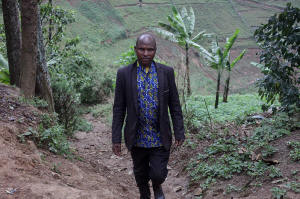In Uganda, a vibrant tourist economy boosts the conservation of
endangered mountain gorillas
[September 24, 2025] By
RODNEY MUHUMUZA
BWINDI, Uganda (AP) — News of a sick or injured mountain gorilla can
worry local residents in this mountainous area that’s home to the
endangered species. That’s partly because most of the gorillas have been
given names, allowing rangers and others to humanize the animal's
suffering.
But widespread interest in protecting mountain gorillas also comes from
the economic benefits of tourism that have turned poachers into
conservationists, married women into porters and rangers into eloquent
spokespeople for the great apes.
“If we know there is a gorilla that is sick, you see everyone is
concerned. ‘Why? Why is the gorilla sick? It’s suffering from what?’”
said Joyleen Tugume, a ranger-guide in Uganda’s Bwindi Impenetrable
National Park. “Even the community people. Everyone is touched.”
Tugume said poaching in the park is increasingly rare since “we are
actually all working together to make sure conservation goes well,
because we are all benefitting.”
Bwindi Impenetrable National Park, a UNESCO World Heritage Site in a
remote part of southwestern Uganda, is home to many groups of habituated
gorillas that have become comfortable in the presence of humans.
Vibrant tourist economy
Tourists pay a considerable sum — $800 in permit fees per foreign
non-resident — for the right to see gorillas in their natural habitat.
An official revenue-sharing policy channels $10 from each permit back to
the local community via their elected leaders, who can invest in
projects ranging from water provision to health care. Local communities
are also entitled to 20% of all park entry fees generated annually.

Many locals, including reformed poachers living near the park, told The
Associated Press that the money generated has ensured the recovery of
the species, with habitat encroachment and poaching in decline as
wildlife authorities seek to collaborate more with nearby communities.
Philemon Mujuni, a poacher until five years ago, said he once thought of
the gorilla as a hostile animal to be killed before it killed him if he
ever encountered one. As a boy, he used to follow his father, whom he
described as “a senior poacher,” into the forest to help carry the
antelopes they pulled from traps.
But in 2020, when poachers killed a beloved gorilla named Rafiki, Mujuni
and others formed an organization of former poachers who now say the
primates are more important than any other animal.
They serve as community watchdogs, looking out for people who might
venture into the forest to set duiker traps that sometimes ensnare
gorillas. Their surveillance efforts help support the work of armed
rangers who also regularly patrol the park.
“When community conservation rangers sensitized us, we said, ‘Let us
reform and stop poaching in the national park of Bwindi,’” Mujuni said.
“I can’t go there. Because, through the conservation team from (Bwindi
Impenetrable National Park), we get some money from these gorillas we
could kill.”
[to top of second column] |

Philemon Mujuni, a reformed poacher, walks up a hill to his home at
the foothill of Bwindi Impenetrable National Park in southwestern
Uganda, Tuesday, Sept. 16, 2025. (AP Photo/Onen Patrick)
 Reformed poachers
Peter Tumwesigye, one of 128 members of the group of reformed
poachers, said gorillas are so important that people whose actions
lead to a gorilla's death should be jailed.
“So that others can learn and never do it again,” he said.
Many of the world’s remaining mountain gorillas live in the Virunga
Massif, a mountainous area encompassing parts of Congo, Uganda and
Rwanda.
The outlook for mountain gorillas has been positive since 2018, when
a survey showed that the population exceeded 1,000. It's a
remarkable comeback for a species that faced extinction in the last
century.
The International Union for Conservation of Nature, which maintains
a list of threatened species, cites the mountain gorilla as
endangered, an improvement from its earlier designation as
critically endangered. About half of the gorillas live in Uganda.
Besides Bwindi, the only other Ugandan park where gorillas can be
tracked in the wild is Mgahinga Gorilla National Park. But that
protected area has just one family of gorillas, while Bwindi has 27
groups that can be seen up close by visitors.
The primates are tracked daily. Tugume, the ranger-guide, said she
works even on Christmas Day. One recent morning she led a small
group of tourists into the forest, swinging a sickle to clear the
way and speaking of the tenderness she sees in gorillas.
“You have to fight to take over,” she said, talking about a young
male in a family of gorillas that one day could challenge the leader
— known as a silverback for its distinguishing coat — for mating
rights.
“When you are the leader, you have all the rights to mate with the
females. But when you are not the leader, you don’t need to mate but
you can mate secretly. And if the silverback comes to know, then it
will be a tug of war,” she said.
At the offices of the Uganda Wildlife Authority in Buhoma, a town
outside the park, a group of ranger-guides and porters gathers each
morning for the opportunity to earn generous tips from helping
tourists navigate the forest.
Groups of trackers are allocated porters, who can even help carry an
unfit tourist up the hills and through the undergrowth for around
$300.
“The value of the gorilla money is very critical,” said Gessa
Simplicious, a conservationist with the Uganda Tourism Board. “It
helps with building trust, but it also helps in the awareness of the
need to conserve.”
All contents © copyright 2025 Associated Press. All rights reserved
 |